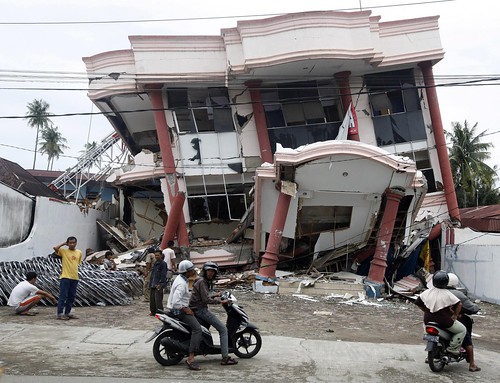PHOTO: People look at a collapsed building in Padang, West Sumatra province of Indonesia on October 1, 2009.
Agencies report that over 1,100 people have lost their lives in the massive earthquake measuring 7.6 on Richter scale that struck at 17:16 local time (10:16 GMT) on Wednesday north-west of Padang, followed by a second tremor, of magnitude 6.8 that hit close to Padang at 08:52 local time (01:52 GMT).
It is feared that thousands of people more are missing or trapped in rubble. The quake razed about 75% of buildings in and around Padang, the capital of West Sumatra, which has a population of over 900,000. Rescuers are still working overnight looking for survivors in the rubble of hundreds of collapsed buildings.
The collapsed buildings include hospitals, mosques, hotels, a mall and homes, and left thousands trapped under rubble. The earthquake cut power lines and phone lines and caused landslides at many places. Many large buildings in the town had been severely damaged and some buildings were on fire. Power has now been restored to some parts of Padang.
As time passes, the scale of this disaster becomes scary. Rescue efforts are hampered by poor communication lines, and damaged roads that have developed very large cracks and craters.
Hospitals in Padang have been severely damaged and injured persons are being treated in tents set up in the open grounds. Many parts of Padang are out of reach for rescue workers, raising fears the number of dead will be much more than initially estimated.
US President Barack Obama, who spent a part of his childhood in Indonesia, said he was deeply moved by the suffering caused by the quake, and added, "Indonesia is an extraordinary country who has known extraordinary hardships from natural disasters. I know that the Indonesian people are strong and resilient and have the heart to overcome this challenge".
Indonesia's location is on the edges where the Pacific, Eurasian and Australian tectonic plates meet. Therefore it is vulnerable to numerous volcanoes and frequent earthquakes. Indonesia has at least 150 active volcanoes, including Krakatoa and Tambora, both noted for their devastating eruptions in the 19th century. The eruption of the Toba super volcano, about 70,000 years ago, was one of the largest volcanic eruptions ever and it is considered a global catastrophe.
Recent disasters due to seismic activity include the Boxing Day tsunami on 24 December 2004 that killed 167,736 people in northern Sumatra (more than 230,000 people in a dozen countries), and the Yogyakarta earthquake in 2006. On 28 March 2005, about 1,300 people were killed after a magnitude 8.7 quake hit the coast of Sumatra.
Indonesia is part of the Pacific's Ring of Fire, a horseshoe-shaped area of seismic activity ringing the Pacific Ocean basin, which is the world's most seismically active region, and 6,000 to 7,000 earthquakes with a magnitude of 4.0 or above hit the region annually. It may be noted that seismologists and geologists have warned time and again that Padang area, which is typically vulnerable and falls on the same fault line that devastated the Aceh area, can be destroyed completely by earthquakes.

0 comments:
Post a Comment